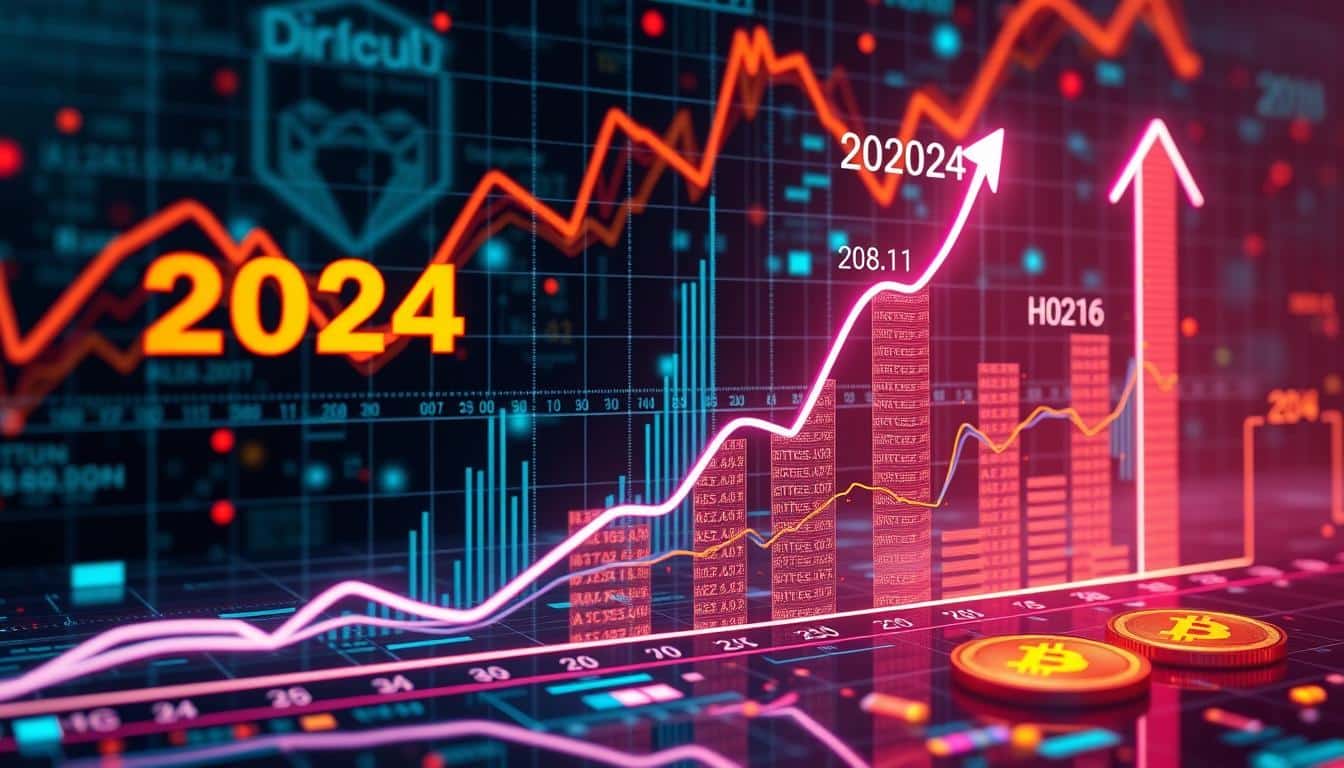2024 Bitcoin Halving Chart: Key Predictions
Did you know the Bitcoin price jumped by 750% after the third halving in May 20201? The next halving is set for April 19, 2024. Everyone in the crypto world is getting ready for this big event. It could really change how we see Bitcoin’s worth and role. Halvings are built into Bitcoin’s programming by the mysterious Satoshi Nakamoto. They help fight inflation and keep Bitcoin valuable over time. When a halving happens, miners get half the reward they used to. This has always made a big difference in Bitcoin’s price, how much computing power is used to mine it, and how people feel about the market. With the 2024 halving coming up, experts think there will be big changes in mining and big ups and downs in Bitcoin’s price.
Key Takeaways
- Bitcoin halving cuts the reward for mining transactions by half.
- The next halving on April 19, 2024, will cut block rewards from 6.25 to 3.125 BTC2.
- Bitcoin prices have always risen a lot after each halving1.
- Bitcoin’s hash rate and the amount miners take to exchanges change a lot with each halving1.
- Experts think prices might go up a lot after the 2024 halving, like before2.
Understanding the 2024 Bitcoin Halving Event
The 2024 Bitcoin halving will cut the reward for mining to 3.125 bitcoins. This is meant to make the digital currency rare like gold and help prevent its value from dropping3. In the past, these events have made mining technology better through necessity34. Because the reward is smaller, some miners, especially the smaller ones, find it hard to make money34
This event is a key moment for the Bitcoin network. It follows a pattern of cutting the block reward, which started at 50 bitcoins in 2009. It was then cut down to 25 in 2012, 12.5 in 2016, 6.25 in 2020, and soon 3.125 in 20243. After the halving, the network’s hash rate may drop as some miners leave. However, it might recover if the price of Bitcoin goes up, making mining profitable again3.
Bitcoin’s total supply is capped at 21 million, making it limited. As of May 2024, about 19.7 million bitcoins were already out there. This leaves only 1.3 million bitcoins left for mining rewards3. This limit is key to making Bitcoin valuable, as scarcity encourages demand3.
Price analysis shows a trend where Bitcoin’s value jumps after each halving. For instance, it rose from $6877.62 to $8821 in the last halving in May 20204. The 2024 halving is expected to push this trend further, possibly raising its value more because of the limited supply4. Big mining companies have grown to stay competitive. One example is Marathon Digital Holdings, which now has 231,000 miners3.
It’s important for investors to understand how halving affects Bitcoin’s value. This knowledge helps to predict market trends and make smart investment choices in this unpredictable but promising area. Watching how Bitcoin and its technology evolves after the halving is very interesting to the cryptocurrency world4.
The Importance of Bitcoin Halving in Cryptocurrency Markets
Bitcoin halving events greatly shape the crypto world. They happen about every four years or after 210,000 blocks. These moments are key to Bitcoin’s plan and its strategy to lessen inflation56.
Historical Significance of Halvings
The first halving was on November 28, 2012. It cut the block reward from 50 BTC to 25 BTC5. This event showed Bitcoin’s plan to reduce its supply works. It pushed the price from $12 to over $1,000 afterward6.
The second halving was on July 9, 2016. It reduced the block reward to 12.5 BTC. This led to the massive price climb in 2017, where Bitcoin nearly reached $20,00056. The third halving, on May 11, 2020, saw the reward drop to 6.25 BTC. It was followed by a price jump to almost $70,00056. These events prove how important halvings are to Bitcoin’s value.
Impact on Market Sentiment
Bitcoin halvings deeply affect market feelings. By decreasing how many new Bitcoins come out, they make the coin seem more scarce. This usually leads to more demand and a rise in prices. The next halving is expected in mid-April 2024. This will lower the reward to 3.125 BTC56. Every time this scarcity comes up, it draws more investors and creates big price changes67. For example, mining groups often have less total Bitcoin right before a halving. They’re getting ready for smaller rewards5. Also, ETFs playing a role now could make the impact even bigger5.
Because of this, investors might change how they buy or sell. They’re getting ready for how the halving could change prices6. Halvings clearly influence how people invest in cryptocurrencies. They lead to market changes and speculative actions among investors. These changes often result in big price moves and investors rethinking their portfolios, ready for less Bitcoin to be available.
Bitcoin Halving Chart 2024
Delving into the Bitcoin halving chart for 2024 means exploring previous price changes, hash rate shifts, and market ups and downs during past halving moments. Studying historical data from these events helps predict future patterns.
Analyzing Past Trends
The Bitcoin halving marks a crucial time in the blockchain world. It happens every 210,000 blocks, roughly every four years. This reduction in block rewards makes Bitcoin scarcer. This scarcity pushes prices up8. For example, after the first halving in 2012, Bitcoin’s price jumped from $12.35 to $127.00 within 150 days8.
The 2016 halving saw prices rise from $650.53 to $758.818. The 2020 event led to an increase from $8,821.42 to $10,943.00 in the same period8. These examples highlight how halvings impact Bitcoin’s value.
Projecting Future Movements
The April 20, 2024, Bitcoin halving cut block rewards to 3.125 BTC. On that day, Bitcoin was priced at $64,994.448. But, differently from past events, the price fell to $60,252.95 after 150 days8. Still, history shows us that such dips usually lead to price increases and more efficient mining thanks to tech progress9.
By the next halving in April 2028, rewards will decrease to 1.5625 BTC8. This supports the idea that lower supply drives higher demand, key for anyone planning their crypto trades.
Looking at past halvings gives us valuable insights for predicting the blockchain market’s future. Successful strategies, however, must be able to adjust to the crypto world’s changes.
Factors Influencing Bitcoin Price Post-Halving
Looking at how Bitcoin’s price changes after a halving, we must consider miner actions and investor bets. Both of these elements are crucial in determining the future price of Bitcoin following a halving.
Miner Behavior and Economics
Miners’ actions and their economic decisions are key in setting Bitcoin’s price post-halving. They prep for the halving by updating their gear and making their mining more efficient to deal with smaller rewards. Before the 2020 halving, many miners made important changes to stay profitable. They mined 262,500 new BTC, which was 87.50% of all mined BTC10.
It’s expected that miners will again boost their efficiency for the 2024 halving. After this event, it’s projected that 1,312,500 new BTC will be mined. This will account for 93.75% of all BTC10.
Investor Speculation and Market Demand
Investor speculation and the demand for Bitcoin often rise around halving events, affecting its price. Looking back helps us guess what might happen next. For instance, Bitcoin’s value soared from $10.26 before the first halving to around $1,003.38 a year after10.
Similarly, before the third halving, the price jumped from about $6,909.95 to $55,847.24 a year later10. These jumps show how expectation and demand can significantly lift Bitcoin’s price, proving the need for careful digital asset analysis.
Bitcoin Halving Impact on Miners and Their Operations
The 2024 bitcoin halving event is a time of big change for miners. This event is expected on April 19, 2024. It will cut the block reward from 6.25 BTC to 3.125 BTC. This means the daily creation of new bitcoins will drop from 900 to 4501112. The reward cut means a 50% drop in new bitcoin supplies12.
Before the halving, miners are moving more bitcoins to exchanges. In February 2024, Marathon Digital Holdings sold 290 bitcoins for about $19.1 million. Riot Platforms sold 211 bitcoins in January 202411. These moves show how miners are planning for cash flow and operations after the halving11.
Miners must adjust how they operate to stay efficient and cut costs. High power costs and the need for efficiency put smaller miners at risk. They might struggle to stay profitable with current Bitcoin prices11. Yet, big players like Riot Platforms are upgrading their equipment. They bought 31,500 WhatsMiner M60S miners from MicroBT for $97.4 million. This shows they’re getting ready to stay ahead11.
To handle the change well, miners should invest in new equipment and get more capital. Braiins offers tools like Braiins OS and Braiins Manager that help miners stay efficient and control costs. This smart planning keeps miners strong against the challenges of bitcoin halving12.
Technological Advancements in Bitcoin Mining
Bitcoin halvings push forward significant technological advancements in cryptocurrency. The need for more crypto mining efficiency grows as rewards drop. This part talks about the newest efficient mining tech and using renewable energy in Bitcoin mining.
Efficient Mining Technologies
Advances in mining tech are key to better crypto mining efficiency. After the latest halving, the hash price hit a high of $183 per PH per day. This highlights the need for better hardware and software13. Bitfarms made 269 Bitcoin in April, with a daily rate of 9.0 Bitcoin, by using efficient mining rigs13. These developments help use less energy while increasing production, which is vital for keeping profits as rewards decrease.
Adoption of Renewable Energy Sources
Moving towards sustainability, using renewable energy in Bitcoin mining is getting more popular. The 2024 Halving cut mining rewards to 3.125 BTC, making energy costs jump14. Miners are now looking into renewable sources, which helps with adding solar, wind, and hydroelectric power to mining.
Bitdeer and Core Scientific are leading this change. Bitdeer made about 8.8 Bitcoin each day in April through green practices13. Core Scientific mined 803 Bitcoin then, while cutting their energy use13. Moreover, public miners got $1.8 billion in equity in Q1 2024 for renewable investments, showing a strong industry focus15.
In conclusion, aiming for more efficient mining and embracing renewable energy is changing Bitcoin mining. With these tech progresses, the sector keeps growing sustainably and profitably, even with halving challenges.
Bitcoin Halving and Its Effect on Blockchain Network Security
After every halving event, Bitcoin’s block rewards decrease. This affects the blockchain network security. The latest halving in April 2024 cut block rewards from 6.25 BTC to 3.125 BTC16. This can cause the Bitcoin hash rate to go up and down. Miners making less profit might leave, which could make the network less secure17.
Yet, these ups and downs are usually short-lived. Network security gets back to normal as miners upgrade their tech. The 2020 halving, for example, lowered the block reward from 12.5 BTC to 6.25 BTC and helped Bitcoin become more rare and valuable16. This helps keep the crypto market stable, even with some ups and downs17.
The Bitcoin halving happens about every four. It makes the supply of Bitcoin more predictable. This helps the market stay stable and assures investors about low inflation rates and a steady new Bitcoin supply16.
Big mining companies might invest in better mining tech because of the halving. They could use renewable energy sources. This not only makes them work better but also helps keep the blockchain network security strong by keeping a good hash rate.
Comparison of Previous Halvings: 2012, 2016, 2020, and 2024
Looking back at past Bitcoin halvings is key to predicting 2024 outcomes. In 2012, Bitcoin’s price moved from a few dollars to $12, facing low trading activity. Still, by the end of 2013, it hit a high of $1,15218. This showed the market could recover and grow after initial struggles.
The 2016 halving started with Bitcoin at $664. It then jumped to over $17,760 in a year18. This period saw tech improvements like the Lightning Network, making payments quicker and cheaper. Big names like Coinbase and Kraken helped stabilize the crypto market.
In 2020, with the economy uncertain, Bitcoin’s value climbed from about $8,000 to more than $10,000 before the halving19. After the halving, it soared to $67,549 the next year18. Major investors like MicroStrategy began supporting Bitcoin, proving its worth as a digital asset.
Looking at these trends, the 2024 halving brings a mix of forecasts. Analysts see Bitcoin reaching new peaks, from $100,000 to possibly beyond $250,00018. These projections show a strong belief in the market’s future as the halving nears.
| Year | Halving Date | Price at Halving | One-Year Peak | Major Technological Development | Key Industry Players |
|---|---|---|---|---|---|
| 2012 | Nov 28 | $1318 | $1,15218 | N/A | Mt. Gox, Coinbase19 |
| 2016 | Jul 16 | $66418 | $17,76018 | Lightning Network19 | Coinbase, Kraken, Bitmain19 |
| 2020 | May 11 | $9,73418 | $67,54918 | Taproot, Schnorr signatures19 | MicroStrategy, Grayscale, Coinbase19 |
Cryptocurrency Investment Trends Moving into 2024
As 2024 approaches, the world of cryptocurrency investments is buzzing. The anticipation of the bitcoin halving chart 2024 plays a big role. Investors are cautiously optimistic about where the market is headed.
Market Sentiment and Predictions
A recent survey shows that 56% of crypto owners think the market will rise in 202420. Their optimism comes from Bitcoin’s climb from $44,000 to nearly $70,000 by late May 202421. The upcoming Bitcoin halving is expected to cut new Bitcoin supply, possibly boosting its value further22.
Bitcoin’s value stayed strong at $67,500 after the halving, beating many expectations22. When Bitcoin hit a record $73,000 in March 2024, it made investors even more hopeful about the future22. This upbeat mood is pushing the adoption and ownership of virtual currencies up.
Predictions place Bitcoin’s value between $77,000 and $123,000 by the end of 2025, exciting investors21. Big investments by major firms like BlackRock and Fidelity, holding billions in Bitcoin, support this optimism21.
Potential Opportunities and Risks
With the booming market come opportunities, but risks can’t be ignored. For example, 63% of crypto owners plan to buy more, showing market growth potential20. Yet, concerns about regulation loom large as 63% of non-owners call for more government oversight20.
Investors are looking at chances in tech advancements and related fields too. The value of AI tokens exploded from $2.7 billion to over $39 billion in just a year, showing diversification prospects21. Mining companies’ stocks have also surged, offering attractive investment options21.
Market instability and new regulations pose significant threats. The expected approval of Bitcoin ETFs in 2024, seen positively by 46% of Americans, brings its own set of challenges20. Legal actions by the SEC against major crypto firms highlight possible regulatory pressures21.
To sum up, the cryptocurrency investment scene in 2024 is set for change with the bitcoin halving and ongoing trends. Investors must weigh the promising opportunities against the risks in this evolving market.
Expert Predictions on Bitcoin’s Future Price Post-2024 Halving
Experts and analysts have different views on Bitcoin’s price after the 2024 halving. History shows us that Bitcoin’s value tends to spike after each halving. For example, the price jumped from about $12 to more than $200 within a year after the 2012 halving23.
In 2016, the price soared from roughly $650 to $19,70023. Following the most recent halving in May 2020, the price climbed from $8,787 to nearly $69,000 by November 202123. This pattern leads many to forecast a price increase after the 2024 halving.
Expert crypto analysis suggests a wide range of potential prices for Bitcoin in 2024. Gov.Capital predicts a price of $91,245, while Trading Beasts see it at $88,632, and DigitalCoinPrice at $78,71724
Looking beyond 2024, experts foresee more gains. Gov.Capital estimates a 2025 price of $123,352. Meanwhile, forecasts from DigitalCoinPrice, Trading Beasts, and Bernstein Analysts range from $110,963 to $200,0002425
Famous investors also have high expectations for Bitcoin. Robert Kiyosaki thinks it will exceed $100,000. Adam Back predicts it will hit new highs above this mark24.
Jurrien Timmer from Fidelity believes Bitcoin could reach up to $1 million by 2030 using Metcalfe’s Law25. ARK Invest goes even further, suggesting a potential $1.5 million value by 203023.
Many firms and analysts have given detailed predictions for Bitcoin’s price in the coming years, as shown in the table below:
| Firm/Analyst | 2024 Prediction | 2025 Prediction |
|---|---|---|
| Gov.Capital | $91,245 | $123,352 |
| DigitalCoinPrice | $78,717 | $110,963 |
| Trading Beasts | $88,632 | $154,435 |
| Bernstein Analysts | – | $200,000 |
| ARK Invest | – | $1.5 million |
The 2024 halving is causing a buzz. The mix of expert analysis and historical data suggests big price increases could follow. Keep watching these predictions to stay ahead in the crypto game.
Conclusion
The 2024 Bitcoin halving event is a big deal for Bitcoin and the whole crypto market. Set for April 2024, it’ll be the fourth time the event happens. It cuts the reward for mining a block from 6.25 BTC to 3.125 BTC26. In the past, these halvings led to major jumps in Bitcoin’s price and shook up the market.
With the fourth halving on the horizon, it’s important to think about what it means for the future. By then, about 19.5 million bitcoins will be out there, close to the 21 million limit. This event will make new bitcoins scarcer, possibly driving up demand and prices27. The rise in demand could be spurred by more institutions adopting Bitcoin and the SEC okaying Bitcoin ETFs28. Past halvings have shown how changes in miner actions and investor bets can steer market trends after the halving.
As we look ahead, it’s key to focus on regulations and Bitcoin’s growing appeal as a way to spread out investment risks. Times of geopolitical shakes and economic ups and downs often push people towards Bitcoin. It becomes a sought-after asset for those wanting to avoid the usual market risks28. The 2024 halving thus stands at a crucial crossroads, tying into past patterns while bringing new challenges to the crypto world. For deeper insights, check out: Digital Asset Research and highly anticipated cryptocurrencies.







